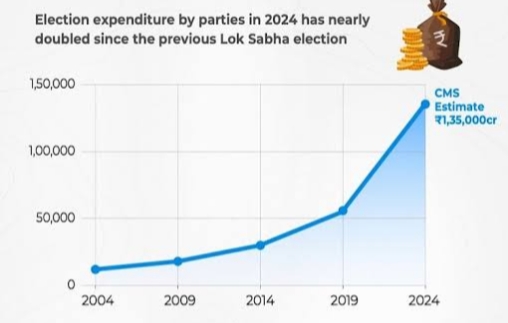Electoral Reforms are essential to ensure country’s electoral process remain fair, transparent and efficient. Over the years India has Implemented Various Reforms to address challenges and improve electoral system. Article 324-329 governs power, function and responsibility of Election Commission Of India. No System of election can be perfect and every democratic society has to keep searching for mechanism to make election free and fair.
WHAT IS ONE NATION ONE ELECTION?
In Simple words it means that Lok Sabha assembly and local body, whether urban or rural, election will be held in the same year if not at the same time. There was a norm from Independence to 1967, four electoral cycle were held beginning with first general elections in 1951/52. The premature dissolution of some state government in 1968 and 1969 as well as early termination of Lok Sabha itself in 1970, meant Simultaneous polls cycle was broken, it was only for central and state government. Article 172 of Indian Constitution specifies the term for state legislative assembly which is five years unless dissolved sooner. At present only seven States vote for a new government at the same time as the country selects a new union administration. Andhra Pradesh, Sikkim and Odisha all voted earlier at the same time during April-June Lok Sabha Elections.
The Union Cabinet has cleared the One nation one Election proposal. The Cabinet accepted the report of the panel led by former President Ram Nath Kovind along with Union Home Minister Amit Shah, Shri Gulam Nabi Azad former leader of opposition of Rajya Sabha and Others by Saying that there is “Unanimous” support for the Idea of One Nation One Election. BJP backed the proposal saying it saves time and money but two dozen parties along with congress have argued against it.
Advantages of ONOE
•This concepts suggests election for Lok Sabha and State Assemblies to be held simultaneously that would consolidate electoral process and reducing the frequency of polls.
•Its benefit is rooted in the efficiency and cost-effectiveness. Conducting elections is an expensive affair, According to the data around 1.35 lakh crore was the cost of election in 2024. Such a hefty amount and holding state elections will add to the burden. Through ONOE government could save billion of rupees and redirect it to pressing causes such as Education, Health care, Infrastructure etc.

•It will also reduce the burden on Election related manpower. India deploys over 10 million personnel as polling officials across 9,30,000 polling station during general elections.
•These campaigns also distracts government and electorate from governance and policy implementation. With Election occurring frequently political parties focus and prioritize short-term populism over long-term developmental policies as they are compelled to win Electoral battles. Hence, a synchronized electoral schedule could mitigate this issue by allowing political leaders to concentrate on governance without constant distraction of impending elections. This could enhance accountability as elected representatives will focus on their duties.
•There will be effective implementation of government programs as government will have longer period to monitor and implement welfare schemes. This would lead to better outcomes and improved public services.
•This will also increase voter turnout as Study shows that in various countries it yielded voter engagement and turnout.
•When State and Nation Election will be held together it will encourage party to have stable alliance, which can lead in effective governance.
Disadvantages of ONOE
While proponents argue that this ONOE would lead to administrative efficiency and financial saving, the opponents or critics cite about their concerns and talk about its disadvantages:
•The Indian Constitution mandates fixed terms for Lok Sabha and State Legislature. Implementing ONOE would require significant amendments to articles of constitution particularly article 83, 85, 172, 174 and 356 which governs the terms and dissolution of legislature.
•If after election no party or coalition is able to form a stable government or if any party withdraws from coalition and state assembly cannot function Constitutional provisions allow for the President rule according to article 356 in state and if state election won’t be held in the same manner it will lead to long Presidential rule i.e more than a year, affecting the state. There was a case of Supreme Court, S.R Bomai V/s UOI, that have set guidelines for presidential rule ensuring that it is applied only in genuine crisis and is subject to Judicial review.
•Federalism could be at stake as this would undermine the autonomy of state government. State level elections are crucial for addressing regional concerns and simultaneous election may lead to homogenization of political discourse.
•This will also be challenging for Regional parties as there would be dominance of National party as they have large resources, greater visibility and well established National leadership which would reduce the space for Regional parties.
•When both the elections will be held Together voters may align their state vote with their preference for national party. This Phenomenon is known as “Nationalization of state election”, this could harm Regional parties as they rely on state specific support.
CONCLUSION
The Idea of ONOE is not merely and administrative proposal but a visionary framework that could significantly reshape political landscape of India. The benefits of enhanced economy, reduced costs and its other advantages presents a compelling case for its implementation. While synchronizing election without violating provisions is challenging but it could be addressed through careful planning and structuring.

